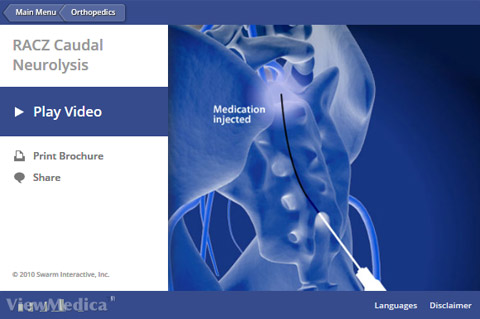Treatments
9. Racz Procedure
Objective: Pain relief and dramatic or even complete recovery of function, without surgery.
This is a minimally invasive 30-40 minute procedure performed under local anesthesia. Indicated for: Acute and/or chronic pain from protruding or herniated disks, irritation of nerve roots, post-nucleotomy syndrome (pain following herniated disk surgery), post-operative epidural scarring and fibrosis, or hypertrophied ligamentum flavum/ hypertrophied facet joint arthrosis. This treatment makes major surgery unnecessary for the majority of patients with protruding or herniated disks. Patients with chronic back pain following back surgery or those with scarring following surgery for facet joint arthrosis can expect dramatic improvement, even complete recovery of function. International literature reports a success rate of over 85%.
Treatment: Racz procedure works by injecting pain and anti-inflammation medications, as well as saline solution, at the source of the pain – the nerve root. If there is scar tissue or anatomic anomaly, a second catheter can be separately inserted in order to overcome them, allowing an injection to reach the exact site of irritation. Inflammation, swelling, and fluid build-up disappear. Oftentimes, we also mechanically free the nerve root from structures that may be adhering to it, by injecting a special enzyme solution that loosens and dissolves scarring and adhesions near the spinal cord.
Time to Relief: You can stand up and move around within as little as one hour. Recovery Time: An in-patient stay usually lasts 3-4 days. During this time you’ll receive 4 further injections of pain medication, saline solution, and enzymes through the catheter.
Post-Treatment: You should begin a coordinated program of physical therapy two weeks after treatment, focused on isometric strength to gradually resume normal sport and fitness activity.
Discharge Instructions: Light physical work such as office work can be resumed after one to two weeks. Heavy physical work should be avoided during the first four weeks and can gradually be resumed thereafter. Swimming and bike riding (i.e. exercise emphasizing upright posture) are allowed after three weeks. Jogging on soft surfaces is possible after four weeks. Other sports can be gradually resumed after the fifth week depending on their degree of intensity.
Technologies: This procedure sets itself apart from other catheter pain management procedures through its unique technology - a flexible catheter specially outfitted with a small probe. This allows for very precise treatment of affected nerve roots. We insert a special cannula into the epidural space of the spine under local anesthesia, in the coccyx (tailbone) for thoracic and lumbar procedures, and in the upper part of the thoracic spine for cervical (neck) procedures. We guide the specially developed probe exactly into place near the spine through the use of image-intensifying technology and contrast medium x-ray. Moreover, we use a catheter with a stainless-steel spring tip that allows for gentle placement without injury.

